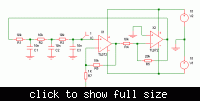SherlockBenedict
Member level 4
Consider an RC phase shift oscillator. I have used op-amp in this case.
For three stages we have frequency of oscillations as
ω= 1/ (2πRC √6)
What is the formula for n-stage RC phase shift oscillator?
Thanks a lot...:-D
For three stages we have frequency of oscillations as
ω= 1/ (2πRC √6)
What is the formula for n-stage RC phase shift oscillator?
Thanks a lot...:-D

